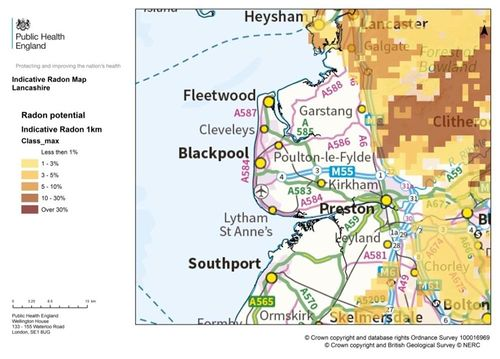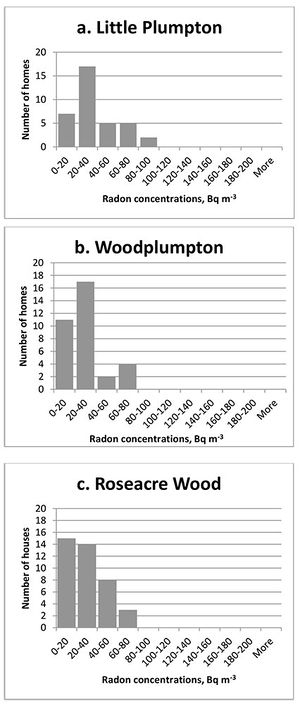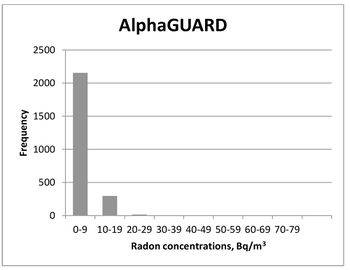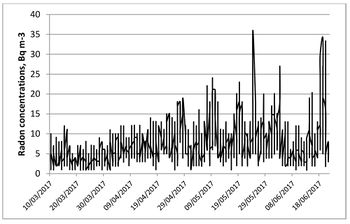OR/18/020 Radon monitoring
| R S Ward1, G Allen2, B J Baptie1, L Bateson1, R A Bell1, A S Butcher1, Z Daraktchieva3, R Dunmore4, R E Fisher5, A Horleston6, C H Howarth3, D G Jones1, C J Jordan1, M Kendall6, A Lewis4, D Lowry5, C A Miller3, C J Milne1, A Novellino1, J Pitt2, R M Purvis4, P L Smedley1 and J M Wasikiewicz3. 2018. Preliminary assessment of the environmental baseline in the Fylde, Lancashire. British Geological Survey Internal Report, OR/18/020. |
Introduction
In 2014, Public Health England (PHE) published a review of the potential public health impact of possible chemical and radiological pollutants resulting from shale-gas extraction (PHE-CRCE-009). Although it was concluded that any exposures from radon released were not expected to add significantly to existing radon exposures, it was recommended to determine initial radon concentrations in areas where shale-gas extraction is planned to take place.
A PHE-funded programme of indoor and outdoor monitoring in Lancashire is currently underway, based on the experience gained in the Vale of Pickering, North Yorkshire, but reflecting the known differences in radon potential in the Fylde area.
The area of Fylde in Lancashire is not considered to be a Radon Affected Area (see Figure 75). This means that fewer local areas are needed for both indoor and outdoor radon monitoring compared with the Vale of Pickering programme. For Lancashire, outdoor monitoring focuses on two areas: around the Preston New Road (PNR) site where shale-gas extraction is planned, to about 2–3 km from the site; and a control site on the Fylde, at least 10 km from PNR and with similar characteristics in terms of overall housing density. The indoor radon monitoring includes also an area around Roseacre Wood, which is another site where shale-gas extraction is being considered.

Outdoor radon monitoring
Two sites have been selected for outdoor radon monitoring in the Fylde:
- Area around Little Plumpton at about 2 km from the Preston New Road (PNR) site — 9 sampling points;
- Area around Woodplumpton at about 10 km from the PNR site, control site — 10 sampling points.
Results from the first 3-month period (March to May 2017)
There are two small aluminium-wrapped plastic pots at each sampling point, which contain four 3-month and four 1-year passive detectors to record radon concentration. The estimated average radon concentrations at each sampling point in the areas around Little Plumpton and Woodplumpton are presented in Figure 76a and b.
The analysis of the detectors for the first 3-month period indicates that the average radon levels were the same around the PNR and control sites:
- 4 ± 1 Bq/m3 for the area around Little Plumpton
- 4 ± 1 Bq/m3 for the local control area around Woodplumpton
The above results are similar to those measured in previous studies (Wrixon et al 1988). It should be noted that the 3-month results are close to the detection limit for the passive radon detection technique.

Indoor radon monitoring
Results from the first 3-month period (May to July 2017)

Three areas were selected for indoor radon monitoring in the Fylde: the area around Little Plumpton, (at about 2–3 km from the PNR extraction site), the area around Roseacre Wood and the area around Woodplumpton, a control site. The control site was chosen to be situated within a similar distance of both the PNR site and Roseacre Wood site. In early April 2017, 600 invitation letters were sent to householders in the areas around Little Plumpton, Woodplumpton and Roseacre Wood. There were 135 positive replies (23% response rate). In early May 2017, detectors were sent to householders who agreed to monitor radon in their homes in the target areas around Little Plumpton, (51 houses), Roseacre Wood (47 houses) and Woodplumpton (37 houses). Each participating householder was sent a pack containing 4 detectors, two for the living area and two for the bedroom. One set was to be placed for 3 months and one set for a year. By the end of August 2017, 111 householders had returned their three-month detectors. The analysis of the 110 results for the first 3-month monitoring period (May to July 2017) is included in this report. Reminder letters were sent to participants who had not returned their detectors. The second set of back-to-back 3-month detectors was sent to 140 householders (5 joined later) at the beginning of August 2017.
The annual average radon concentrations were calculated employing seasonal correction factors as outlined in the PHE Validation scheme (Howarth and Miles, 2008[1]). Distribution parameters were calculated for each area, assuming log-normality. The results for the homes around Little Plumpton, Roseacre Wood and Woodplumpton are consistent with the expected low radon potential for this area.
| Area (number of homes) | First 3-month results (May–July 17) (Bq/m3) | |||
| Range | Arithmetic mean (AM) | Geometric Mean (GM) | Geometric Standard Deviation (GSD) | |
| Little Plumpton (36) | 6–92 | 40 | 33 | 1.9 |
| Woodplumpton (34) | 8–92 | 29 | 25 | 1.7 |
| Roseacre Wood (40) | 10–77 | 26 | 30 | 1.7 |
Local radon distributions for the first 3-month test in homes in and around Little Plumpton, Woodplumpton (control area) and Roseacre Wood are given in Figure 77a, b and c, respectively.
Monitoring at preston new road site
Data from an AlphaGUARD radon detector, placed in an enclosure at the Preston New Road site for periods March–June 2017, are plotted in Figure 78. The background of the instrument was taken into account when the data were processed. The radon data, taken at 1-hour intervals, are log-normally distributed. The distribution parameters for the above monitoring period are given in Table 2. The average radon concentration measured with the passive detectors in the enclosure was 7 ± 2 Bq/m3. The value is in good agreement with the arithmetic mean of the distribution, 6 Bq/m3, in Table 16. Time series of the measured radon (without background correction) are given in Figure 79.

| Period of monitoring | Bq/m3 | |||
| Range | AM | GM | GSD | |
| March–June 2017 | 1–35 | 6 | 5 | 1.9 |

References
- ↑ HOWARTH, C B, and MILES, J C H. (2008). Validation scheme for organisations making measurements of radon in dwellings: 2008 revision. Chilton, HPA-RPD-047.